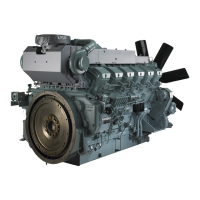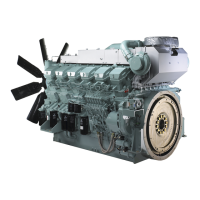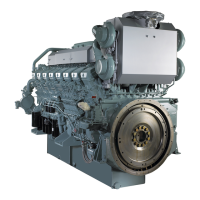Chapter 3 OPERATION
3-12
Starting
The starting method varies depending on the appli-
cation and specifications. Start the engine accord-
ing to the specified procedure.
Before starting the engine, check to make sure
no one is near the engine and tools are not left
on or near the engine. In loud voice, notify peo-
ple in the area when starting the engine.
Never load the engine at starting time. (Disengage
the clutch if it is installed.)
1 Check to make sure the air tank internal pres-
sure is 2.94 MPa (30 kgf/cm
2
) [426 psi].
2 Open the air tank main valve.
3 Set the start lever to OPEN or press the Start
button to start the engine.
After confirming the engine startup, set the start
lever to CLOSE and close the air tank main
valve.
In the case of automatic startup, keep the air
tank main valve open.
If the engine does not start, wait for 2 minutes,
then set the air tank pressure to the specified
level and start the engine again.
Note: If the engine fails to start after three attempts,
contact a Mitsubishi dealer.
Warming-up Operation
Do not approach rotating parts while in opera-
tion.
Entanglement by rotating parts can cause seri-
ous injury.
Do not conduct warm-up operation for an extended
period of time.
Prolonged warm-up operation causes carbon
buildup in the cylinders that leads to incomplete
combustion.
Emergency engines do not require a warm-up
operation since they start up for immediate opera-
tion. However, be sure to check all items on the
inspection and maintenance chart.
Do not operate the engine under excessive load
(indicated by discharge of black smoke) during a
warm-up operation. Operating the engine under
excessive load not only consumes fuel unnecessar-
ily, but also causes incomplete combustion, which
can result in carbon deposits and shorten the
engine service life.
Conduct a warm-up operation according to the
ambient temperature.
When the air temperature is lower than 5
o
C [41
o
F],
operate the engine under no load and at low idling
speed for 5 to 10 minutes.
When the air temperature is higher than 5
o
C [41
o
F], operate the engine under no load and at low
idling speed for at least 20 seconds.
The above guidelines for warm-up operation do not
apply when the engine is equipped with an auxiliary
starting device (water heater, engine oil priming
pump, etc.).
Inspection of Oil Pressure
During warming-up operation, check if the oil pres-
sure is in the range of standard value.
Also, make sure the oil pressure gage is operating
properly.
Oil pressure standard value during warming-up:
0.20 to 0.39 MPa (2.0 to 4.0 kgf/cm
2
) [29 to 56.56
psi] (at low idling)
Note: The oil pressure gage indicates higher pres-
sure than normal immediately after the
engine starts since the oil temperature is low.
This does not denote an abnormality. The
pressure gradually lowers to the normal level
as the oil temperature rises.
External Inspection during Warming-up
Check the external view of the engine to make sure
there is no fuel, oil, cooling water or exhaust gas
leakage from joints.

